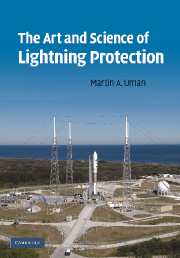Book contents
- Frontmatter
- Contents
- Preface
- 1 What is lightning?
- 2 Lightning damage
- 3 General methods for lightning protection: Faraday cages, topological shields; and more practical approaches: cone of protection and rolling sphere methods
- 4 Structure protection: air terminals and down conductors
- 5 Structure protection: grounding
- 6 Surge protection for electronics in low-voltage electrical systems
- 7 Humans and animals
- 8 Lightning warning
- 9 Airships, airplanes, and launch vehicles
- 10 Ships and boats
- 11 Trees
- 12 Overhead and underground power and communication lines
- 13 Lightning elimination
- 14 So, what do we know and what don't we know about lightning protection?
- Index
- References
5 - Structure protection: grounding
Published online by Cambridge University Press: 17 November 2009
- Frontmatter
- Contents
- Preface
- 1 What is lightning?
- 2 Lightning damage
- 3 General methods for lightning protection: Faraday cages, topological shields; and more practical approaches: cone of protection and rolling sphere methods
- 4 Structure protection: air terminals and down conductors
- 5 Structure protection: grounding
- 6 Surge protection for electronics in low-voltage electrical systems
- 7 Humans and animals
- 8 Lightning warning
- 9 Airships, airplanes, and launch vehicles
- 10 Ships and boats
- 11 Trees
- 12 Overhead and underground power and communication lines
- 13 Lightning elimination
- 14 So, what do we know and what don't we know about lightning protection?
- Index
- References
Summary
Overview
The primary purpose of a lightning grounding system is to provide a means to direct lightning current from the down conductors into the Earth while minimizing the voltage rise on the protection system. For example, if a relatively high peak current Ip of 100 kA is injected into a grounding electrode with a resistance Rgr of 25 ohms, the peak voltage Vp on the metal components of the above-ground protection system due to the current flowing through the resistance Rgr will be Vp = Rgr × Ip, and hence will be equal to 2.5 × 106 volts (see Sections 2.3 and 4.4). This voltage level will lead to side flashes from the above-ground system to any isolated (or grounded at a distance) conducting bodies (metallic or human) within about 5 m of the protection system, since the average electric field for breakdown in air is about 500 kV m− 1 (see Section 3.3). To eliminate such side flashes and the danger to individuals near the protection system, one should bond (electrically connect) nearby metallic objects to the lightning protection system conductors. Since half of the peak lightning currents for first strokes are larger than about 30 kA and 90 percent are larger than about 10 kA, and since it is generally impractical to obtain grounding resistances below about 10 ohms except in the very best conducting soils, the lowest expected peak voltage on a down-conductor system will generally be hundreds of thousands of volts.
- Type
- Chapter
- Information
- The Art and Science of Lightning Protection , pp. 85 - 98Publisher: Cambridge University PressPrint publication year: 2008



